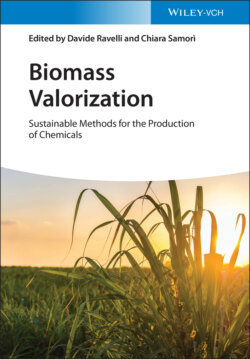Читать книгу Biomass Valorization - Группа авторов - Страница 16
1.5 Solvents
ОглавлениеSolvent selection is an important factor in the viability of biomass processes. Aqueous solvents are advantageous for high solubility with most biomass feedstocks. Other desirable factors of aqueous solvents are low cost and low environmental impact, especially when compared to other solvents. Water, for instance, is the ideal solvent for biocatalytic routes as they have fewer chances to denature the used microorganism [56]. However, a downside of using water is usually the higher energy‐intensive separation processes, hence higher cost [57]. From the chemical point of view, aqueous solvents typically facilitate many side reactions that lower yields, including decomposition and polymerization [58–61]. In fact, many of the mechanisms of humin formation (i.e. sugar platform chemical polymer with low current market value) are attributed to ring‐opening hydrolysis [62]. The use of organic solvents can overcome this type of mechanism and maintain a low environmental impact if the process is designed to recycle said solvents. Polar aprotic solvents can offer higher yields of the desired products compared to aqueous systems thanks to high sugar solubility and suppression of side reactions [63,64]. However, most polar aprotic solvents, such as dimethyl sulfoxide (DMSO), have high boiling points that make product separation more difficult and significantly increase production costs.
Other conventional solvents have certainly been employed in biomass applications as well, but focus has been placed on coupling biomass processes with bio‐based or green solvents. These include bio‐based conventional solvents, terpenes, ionic liquids, switchable solvents, fatty acid/glycerol‐based solvents, and liquid carbon dioxide.
Conventional bio‐based solvents can mostly be used as a drop‐in replacement. Common examples of this are glycerol, ethyl lactate, and 2‐methyltetrahydrofuran. In addition, acetone and various linear alcohols (e.g. methanol, ethanol, and butanol) can be derived from bio‐based sources, but current technology is not the most efficient [65]. The use of these solvents may offer an advantage, given the chemical affinity to the desired platform biomolecules. These solvents alone, however, have also induced the formation of humins.
Terpenes can be extracted from various materials in nature and subsequently used as a bio‐based solvent. Cis‐rich pinane can be extracted from pine tree by‐products and used as a suitable replacement for n‐hexane [66]. Another example, D‐limonene, has similar properties and comes from orange peels. It has been safely designated by the USFDA for use in home and personal products [65]. However, the small volumes of these potential solvents limit their use to specialty applications (e.g. cosmetics).
Ionic liquids (ILs) are also being explored as solvents for biomass processes. Recently, they have been a major focus in biomass applications for their potential to overcome other solvent limitations because of their versatility (i.e. large working temperature range, acidic or basic capabilities, and compatibility with different materials) and non‐volatility. Initial studies show that ionic liquids can offer satisfactory product yields when combined with metal halides. In fact, whereas the ionic liquid provides a stable medium for sugar conversion, the halide acts as Brønsted acid catalyzing the system. Another advantage of using ionic liquids is that they are generally considered to have high stability. However, application of ionic liquids is still a relatively new field and the physicochemical properties are not properly defined, in the end causing safety concerns [67]. The major issue related to the use of ionic liquids, however, is the hindered separation of oxygenated products such as furanics, given the higher stability of these molecules in charged media [68].
Switchable solvents are attractive for coupling desirable solvent properties that would otherwise be on the opposite ends of the spectrum. Switchable solvents are able to quickly undergo reversible property switches that are activated by an external change. The external trigger is typically a change in pH, temperature or concentration [65]. Switchable solvents are like biphasic solvents in that they both can possess two different solvent properties in just one system. One highly desirable solvent property for manipulation is hydrophilic character [69]. A switchable hydrophilic solvent (SHS) has been used for extracting different fractions such as proteins, lipids, and carbohydrates from microalgal biomass [69] and also for extracting phenols from lignin pyrolysis oil [70]. The SHS employed in both of these studies was N,N‐dimethylcyclohexylamine [69,70]. However, limitations are present with switchable solvents as it is a newer field lacking in research.
Other solvents worth noting are fatty acid/glycerol‐based solvents, advantageous for chemical inertness, and liquid/supercritical CO2, advantageous for wide availability, good solubility, and low toxicity [65]. The high boiling point of the glycerol mixtures (higher than DMSO) may be used as an advantage for separating volatile molecules but hinders their recyclability if nonvolatile molecules are coproduced (e.g. humins). Alternatively, employing liquid/supercritical CO2 as a solvent indicates costly high‐pressure systems/vessels and additional safety requirements.
Another solvent approach is the use of biphasic systems. With two different phases, reactions take place in the aqueous phase but extraction and separation in the organic phase [5971–74]. Hydrophobic extracting phases (e.g. cyclopentyl methyl ether, CPME) in the presence of a chloride salt (e.g. NaCl) can enhance the partitioning coefficient of the organic solvent, favoring extraction [71]. Otherwise, polar solvents with low water solubility (e.g. methyl isobutyl ketone, MIBK) can be used in the sugar conversions. Even so, the addition of multiple solvents increases the production costs even if recycled (small loss of solvents, specialty molecules) and reduces the greenness of the overall process.
By using these (mixtures of) solvents, one‐pot transformation of lignocelluloses via different methodologies has been attempted [50]. However, one‐step procedures are difficult to achieve with biomass processes because of the intricacies associated with solvent selection, catalyst, and other operating conditions. With this in mind, biomass processes that focus on individual bio‐components as opposed to entire systems could be more effective.
